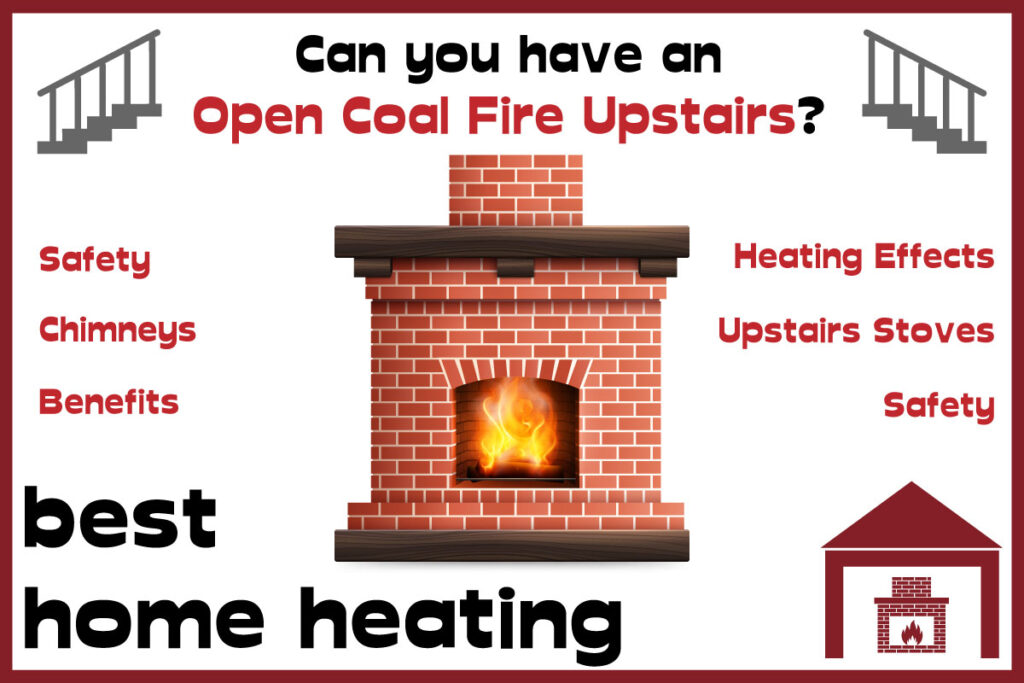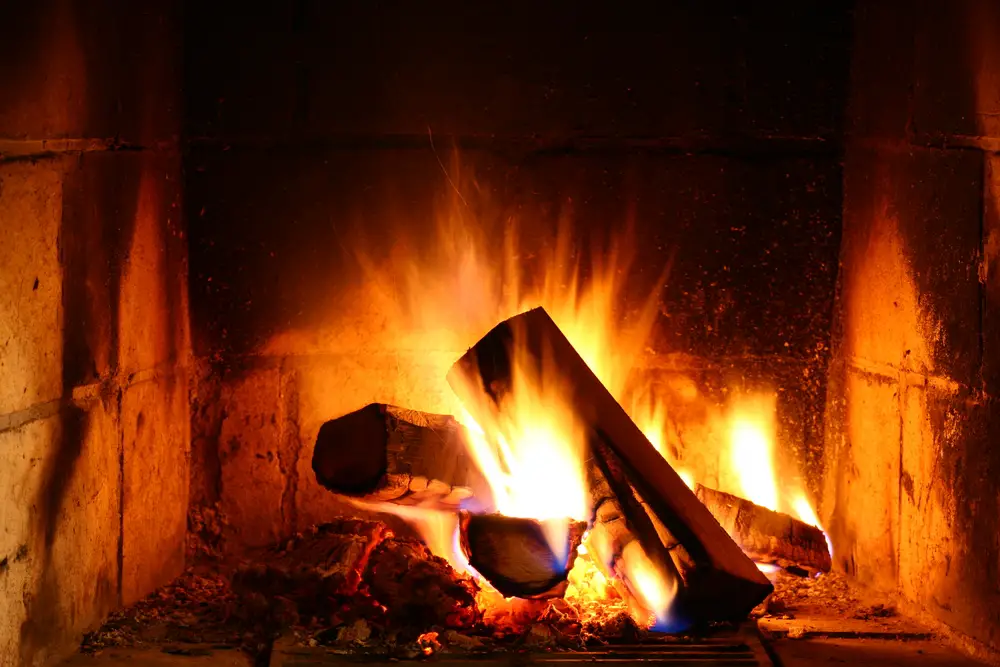Let’s explore the key considerations and possibilities of this traditional open coal fire upstairs heating option in a modern setting.
Yes, having an Open Coal Fire Upstairs is possible but requires careful planning and adherence to safety regulations. Adequate ventilation, proper flue installation, and regular maintenance are essential to ensure safe and efficient use in a modern setting.
Interested in learning more about the possibility of having an Open Coal Fire Upstairs? Read on to find out the key considerations and safety measures you need to know!

Can you have an open coal fire upstairs?
Coal cannot be burned in any fireplace whether upstairs or downstairs; it requires more precise handling and ventilation than wood. If you have a functional Rumford-style coal fireplace and the appropriate fittings, you’re good to go.
Why you should have one upstairs?
Having an open coal fireplace upstairs will bring more warmth to the rooms. A coal fireplace with golden burning coal adds more character to the rooms. Coal heat is also more stable and more intense than the heat produced by burning wood.
Problems
A coal fireplace on the upper levels may result in a sizable quantity of downdraft via the same chimney on lower floors, filling the rooms with smoke. You won’t run into this problem if you turn on the bottom fireplace at the same time. With a coal fireplace upstairs, there could be downdrafts of carbon monoxide downstairs, which is dangerous.
One more problem that has less to do with the open coal fireplace being upstairs or downstairs and more to do with the nature of the fireplace is left behind ashes. Fewer people are aware of the fact that the coal ash that is left behind after burning it in the fireplace in the middle of your living room may potentially be more damaging over time, especially if it is disturbed and spreads into the air. These ash grains can lodge in your lungs and collect in the mucus linings, and silica, one of the components of ash, can cause silicosis, a highly dangerous illness if breathed. Ash contains a variety of different chemicals that might irritate your skin, eyes, and respiratory system.
Chimney type
It is always better to have separate chimneys for the upstairs and downstairs fireplaces. If you have the same chimney, a lock top damper should be fitted to stop smoke from going downwards. It is simple to install and seal the disused chimney to stop any undesired draughts from occurring (up or down). A lock-top damper has a tight seal, so almost no air and hence little heat or cooling escape up your chimney.
Class A chimney pipe is also known as double-wall, triple-wall, all-fuel, or insulated chimney pipe. High-temperature exhaust from wood, coal, and oil-burning appliances such as fireplaces, stoves, boilers, and furnaces is vented using class A pipe.
Is it safe?
It is safe if you have a separate chimney for it. A separate coal fireplace upstairs would also bring warmth to the room in which it is installed. However, if you have the same chimney serving the open fireplace upstairs and downstairs, then it might not be a safe idea to have one. In this case, downdrafts may enter the rooms downstairs from the chimney. The fumes of the coal-burning fireplace are usually carbon monoxide which is dangerous if inhaled.
To sum it up, a separate open coal fireplace upstairs is perfectly safe if you have a separate chimney for it. It will bring an extra level of warmth and character to the rooms upstairs.
Can you have a wood-burning stove upstairs
Even if you have perfected the skill of making a fire, the placement of your stove will likely prevent it from adequately distributing heat throughout your home. Installing your wood-burning stove downstairs is essential if you want it to evenly disperse heat throughout your house. Heat rises, thus ground-floor stoves may readily transfer their heat to rooms upstairs. Installing vents in the ceiling of the room where the wood-burning stove is placed, as well as vents in any upstairs rooms you want to benefit from the fire’s heat, can help the heat from the stove spread more widely.
Convection heat from your stove will rise through your roof and diffuse into spaces with additional vents, improving energy efficiency across the entire house. Installing a fan above the stove, intended to circulate warm convection currents around your house and force heat into the room, will improve this impact.
However, in case you want to have a separate wood-burning stove upstairs, it is perfectly safe to have one unless you have a separate chimney for it.

Best place to have a wood-burning stove in double-story homes
A wood stove must be installed properly in order to provide the best possible heat distribution throughout your home. The stove should ideally be located on the level where you spend the most time. Many wood stoves are put on the main floor of the home rather than the basement since heat does ascend if provided a suitable channel for airflow. Because the warm air within the home will pull the air in the chimney up, wood stove chimneys draw better if they are routed through the middle of the house rather than up an outside wall or outside the building. Therefore, attempt to position the wood stove as close to the middle of the house as you can in order to heat your home as efficiently as possible.
Best way to utilize the heat of a downstairs wood-burning stove on the second floor
A vent should be carved into the upper level’s floor to aid in the movement of warm air from the home’s bottom level to the second story. To assist convey the warm air and maintain good air circulation between the two floors, this vent should be placed as close to the wood burner as feasible and should be at least 15 inches square. Additionally, fans should be employed to lower the air to the area underneath the stove. As a result, the downstairs will be under pressure and the hot air will be forced to rise.
Problems with having wood burning stove upstairs
Because of the fire-burning stove upstairs, the lower floor chimney can experience a substantial quantity of downdraft, which will cause smoke to flood the lower floor. You can avoid this problem if you also use the fireplace in the lower at the same time, but it is not very feasible to use both fires continuously. Another way to avoid this issue is to have separate chimneys for the upper and lower floors.
Is it safe?
Yes, they are. In essence, you may install a wood stove in your home’s second-story without any problems. There are definitely a few crucial safety factors to take into account, some of which may turn out to be impractical:
- In order to have a wood-burning stove upstairs, you must ensure that it is linked to your chimney (which may be challenging from the second level in most structures) and that your chimney is in good operating order, as well as well insulated and vented.
- A non-combustible hearth would need to be fitted with the wood-burning stove. Additionally, work would need to be done where appropriate to ensure that the flooring upstairs complied with non-combustible laws.
- It is possible for upstairs rooms to be more closed off and less naturally ventilated. It would be important to take precautions to make sure the upstairs room is well-ventilated in order to prevent the hazards of carbon monoxide poisoning.
Cost of installation of open fireplace upstairs
It will cost around 1900 to 3000 $ to install open coal or wood-burning fireplace. This cost includes the cost of the chimney, which is necessary if you are installing it upstairs. One benefit of a conventional fireplace is that the firebox does not require masonry support. The chimney has a flue, liner, damper, and roof flashing in addition to being insulated. These are a fantastic alternative for folks who want to reduce their power costs and have easy access to plenty of wood.
Conclusion – Summarize key points
To sum it up:
- Having an open coal fireplace upstairs will bring more warmth to the rooms.
- It is always better to have separate chimneys for the upstairs and downstairs fireplaces. If you have the same chimney, a lock top damper should be fitted to stop smoke from going downwards.
- It will cost around 1900 to 3000 $ to install open coal or wood-burning fireplace. This cost includes the cost of the chimney, which is necessary if you are installing it upstairs.
